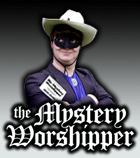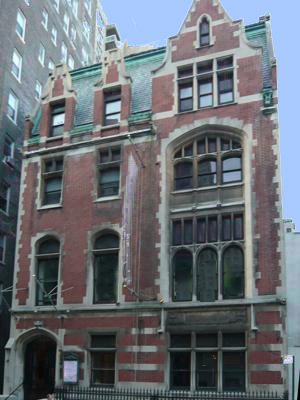| |
 |
 |
 |
| Comment on this report, or find other reports. |
 |
| Our Mystery Worshippers are volunteers who warm church pews for us around the world. If you'd like to become a Mystery Worshipper, start here. |
 |
| Find out how to reproduce this report in your church magazine or website. |
|
|
| 2174: All Angels,
New York City |
 |
 |
 |
Mystery
Worshipper: Acton Bell.
The church: All
Angels, New York City.
Denomination: The
Episcopal Church, Diocese
of New York.
The building: All
Angels currently meets in what was at one time its parish house,
the main 1,500 seat church building having been torn down in
1979. Designed by Henry Janeway Hardenburgh, who also designed
the legendary Dakota Apartments and the Plaza Hotel, the parish
house was built for the astronomical sum of $90,000 in 1906
(approximately $3,000,000 in 2011 dollars). Hardenburgh is famous
for his playful mixing and matching of styles, and that sort
of play is readily apparent here, albeit on a tiny scale, with
Gothic tracery on the windows blended with Flemish dormers and
a giant two-story window that gives the small building a grandeur
that one wouldn't necessarily expect. The original interior
has been mostly gutted and replaced by a small modern, blonde
wood sanctuary that seats about 150. The loss of their original
church building is much lamented, and there is reason to mourn.
By all accounts the interior was breathtaking and featured the
largest Tiffany window ever designed by that studio. There were
also a choir and pulpit ringed with limestone angels that wrapped
around the choir and paraded to the top of the pulpit, which
was topped with a life-sized wooden angel who leaned toward
the congregation blowing a trumpet with wings at full extension.
The church: They
sponsor a very vigorous homeless outreach ministry, providing
showers, food and clothing to those most in need. They also
sponsor home churches and Bible study, 12-step programs, and
a variety of youth and young adult programs. All Angels maintains
a definite fundamentalist bent. In response to the consecration
of Gene Robinson, the openly gay bishop of New Hampshire, they
joined the Anglican Communion Network, a group of conservative
Episcopal churches, in 2006. Although formally still a part
of the Diocese of New York, they have withheld their diocesan
tithe over their disapproval of homosexuality in the clergy.
The neighborhood: It's
hard to believe today that Manhattan's upper west side was ever
a slum, but as late as 1960 The New York Times called
it a "gathering place for narcotics addicts, homosexuals and
sexual perverts." Ironically, gentrification began around the
time All Angels was torn down, as "yuppies" were drawn
to the large apartments and proximity to Central Park. Real
estate prices in the area have now reached the stratosphere,
but the neighborhood somehow feels almost suburban, lacking
true New York City "grit".
The cast:
The Revd Milind Sojwal, rector, was the celebrant. Jason Gaboury delivered the homily. His connection to the church wasn't specified in the service bulletin.
The date & time: Good
Friday, April 22, 2011, 7.00pm.
What was the name of the service?
The Solemnity of Good Friday, with Communion from the Reserved Sacrament and Veneration of the Cross.
How full was the building?
It was pretty near filled to the gills with quite a young, smartly turned-out crowd of roughly 125 souls. I definitely felt I drove the average age up.
Did anyone welcome you personally?
I guessed it was the greeter's first time, and she seemed a
little preoccupied and tentative, but the rector spotted a visitor
and bounded over to say hello and ask how I had heard of the
church.
Was your pew comfortable?
It was a chair with a rush seat and a kneeler. It wasn't uncomfortable.
How would you describe the pre-service
atmosphere?
The choir of three singers and the cellist were practicing,
having some trouble with the harmony on one of the hymns (trouble
that continued as things got underway). A few minutes before
the service began, their very fine organist played what I think
was a Buxtehude prelude, but it wasn't listed anywhere.
What were the exact opening words of the
service?
"Blessed be our God forever and ever. Amen."
What books did the congregation use during the
service?
A service bulletin, although The Book of Common Prayer (1979) was available on the backs of our chairs.
What musical instruments were played?
Organ, piano and cello. The organ is a particularly fine example, with a wonderful sound and perfect for such a small space.
Did anything distract you?
The rector wore a cassock and stole but was shoeless. When he
first came to say hello before the service, I just thought he
was in the process of dressing. But when he remained unshod
for the service, I realized it was part of his shtick. I kept
thinking about how cold his feet must have been (New York is
still decidedly chilly in late April). I was starting to get
sympathy chilblains! There were also two huge frescoes in shades
of black, gray, white and deep purple, which seemed to be illustrations
out of a graphic novel about Jack the Ripper. The one I could
best see had men and women in Victorian dress lying about as
if dead, with chairs and tables upturned around a central disembodied
head and a loaf of bread. I was reminded of a line from Love's
Labour's Lost: "Black is the badge of hell, the hue
of dungeons, the scowl of night." Good for Good Friday,
I guess, but really they were more than a little disturbing,
and totally at odds with the severe, spare aesthetic of the
modernist interior.
Was the worship stiff-upper-lip, happy clappy, or
what?
It was evangelical, but I wouldn't necessarily call it either
happy or clappy. It was the Good Friday service from the Prayer
Book, with veneration of the cross and communion from the reserved
sacrament. There seemed to be some discomfort with liturgy in
general among the congregation, which I didn't quite get. We
were explicitly given the option of standing or kneeling at
the solemn collects, with a majority of the congregation choosing
to remain standing. The rector had to explain that venerating
the cross didn't necessarily mean worshiping the cross, but
recognizing all the same that some might find it discomforting
and were under no obligation to do it. Some chose to do it,
others not. The one divergence from the standard rite was the
addition of what I'm calling "prayer stations," although
I'm not really sure what they would correctly be called. Jason
Gaboury, the preacher, invited us to "recommit ourselves
to Christ" in a "celebration of his suffering and
our cleansing reception into his body" at stations set
up alongside communion. Jason and someone named Christine stood
next to the rector, who was distributing the host, and laid
hands on and prayed a "recommitment prayer" over those
who had just received communion.
Exactly how long was the sermon?
I was surprised to see it clock in at 30 minutes. It seemed much, much longer.
On a scale of 1-10, how
good was the preacher?
1 – Jason Gaboury tended to shout and actually pounded
the lectern in several instances to make his point even more
emphatically. I tend to zone out when anyone starts shouting,
so I'm probably not going to do his argument justice, despite
the fact that I was taking notes. I can say with certainty that
the sermon was extemporaneous and, as such, the argument was
very febrile and diffuse.
In a nutshell, what was
the sermon about?
He began with a reference to his young daughters telling their
friends in grade school the story of the crucifixion, saying
he wondered how their teacher, Mrs Goldberg, might react. (This
got a laugh.) But it wasn't so much in the spirit of ecumenism
that he was excited about, but rather that they had taken evangelizing
so to heart. Then he jumped into the business end of things
by claiming that we all share guilt in the crucifixion, just
in the same way we are all complicit in eroticizing strangers
and sex trafficking (in part because we buy things like iPads).
Jesus, however, was beaten (by us), yet he wasn't defeated by
the weight of the world. And if we are transfigured by the Word,
we too can behold man as good. But first we must be cleansed
and meet the sacraments renewed.
Which part of the service was like being in
heaven?
The keyboardist played an improvisation on the piano during
communion that was simply to die for. Also, during the veneration
of the cross, he played Bach's Nun komm der Heiden Heiland
on the organ, which was also particularly well done.
And which part was like being in... er... the other place?
The sermon definitely had me thinking of things sulfurous, and
that wasn't exactly in the spirit of the day, was it? But then
again, it isn't every Good Friday where I am hectored for my
complicity in sex trafficking.
What happened when you hung around after the service looking lost?
There wasn't any coffee hour. People filed out in silence after
venerating the cross, so no chance of looking lost.
How would you describe the after-service
coffee?
A coffee hour on Good Friday would have been a hoot, but regrettably
there wasn't one.
How would you feel about making this church your regular (where 10 = ecstatic, 0 = terminal)?
0 – Somehow I think I prefer my tent revivals slightly less chic.
Did the service make you feel glad to be a
Christian?
Not particularly. With so many people "shouting" all around,
why on earth would I want actively to seek out even more?
What one thing will you remember about all this in seven days' time?
I'll still be scratching my head over the Jack the Ripper cartoons! |
|
|
 |
 |
 |
| We rely on voluntary donations to stay online. If you're a regular visitor to Ship of Fools, please consider supporting us. |
 |
 |
 |
| The Mystery Pilgrim |
 |
| One of our most seasoned reporters makes the Camino pilgrimage to Santiago de Compostela in Spain. Read here. |
 |
 |
 |
| London churches |
 |
| Read reports from 70 London churches, visited by a small army of Mystery Worshippers on one single Sunday. Read here. |
| |
|
|
|
|


